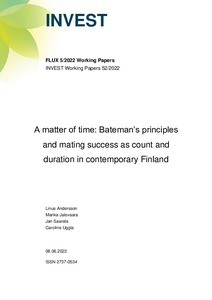A matter of time: Bateman's principles and mating success as count and duration in contemporary Finland
Andersson Linus; Jalovaara Marika; Saarela Jan; Uggla Caroline
https://urn.fi/URN:NBN:fi-fe2022081154535
Tiivistelmä
Bateman’s principles continue to influence the understanding of human reproductive behaviour despite enduring criticism. However, few rigorous studies on Bateman’s principles in contemporary industrialized populations exist, and previous studies are hampered by small sample size and exclusion of non-marital unions. Here we address these shortcomings by assessing mating success and reproductive success using population-wide Finnish register data of marital and non-marital co-habitations and children born. These unique data allow us to compare different operationalizations of mating success, namely, co-residential unions and cumulated union duration; and to examine variability across social strata. Our data support Bateman’s first and second principles but the association between mating success and reproductive success is less clear. The number of unions is somewhat more positively associated with reproductive success for men than women, and the mating success–reproductive success association turns negative when adjusting for union duration. Having had more mates is associated with lower reproductive success than having had one union. More unions are positively associated with higher reproductive success only for men in the lowest income quartile. We conclude that union duration, controlling number of unions, is associated with higher male reproductive success and should be incorporated as an important dimension of mating success.
Kokoelmat
- Rinnakkaistallenteet [19218]
